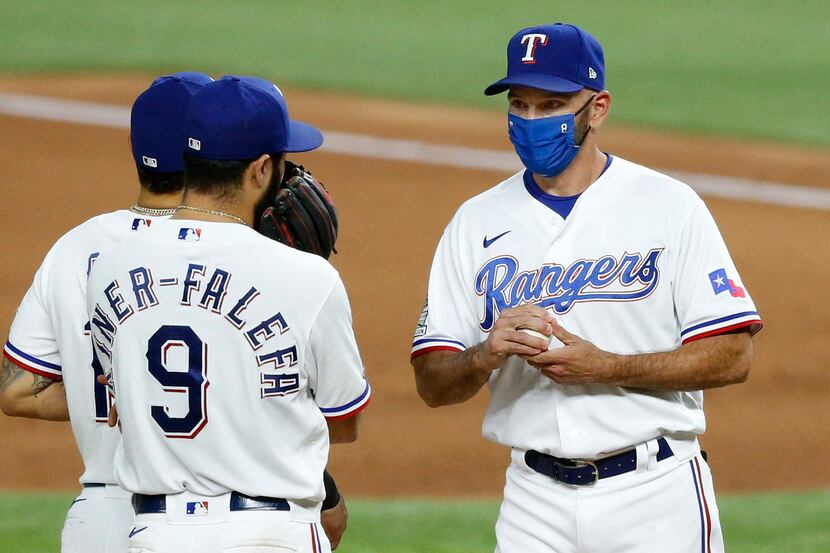Even in the spring of ’72, it was evident the newly-minted Texas Rangers were still little more than warmed-over Washington Senators. Harbingers of a 100-loss season hung over Pompano Beach like early-morning fog. Frustrations mounted daily. When coaches squabbled over the proper method of executing a relay, the boss walked over and settled the argument.
“Aw, [expletive],” Ted Williams said. “Let’s hit.”
The Rangers' response: a .217 team average in their Arlington debut, still a club record, though not for long now.
Barring a last-minute spike of life in the Rangers' bats, it looks as if they’ll make history in hitting futility, raising a question as a result.
If the greatest hitter ever couldn’t help a bad club at the plate, what chance did Chris Woodward have?
Two seasons of the Woodward era are just about in the books, and even though it reflects a smaller sample size than usual, the results aren’t good. The Rangers' averages of 3.6 runs per game and .637 OPS rank ahead of only Pittsburgh, a town where the Steelers do the hitting. Not so long ago, Arlington was considered a hitter’s paradise. A club that made its bones in the batter’s box most of the last three decades now sports a half-dozen regulars foundering below the Mendoza Line.
Of the nine players other than Shin-Soo Choo in Woodward’s lineup the last two seasons, only Isiah Kiner-Falefa, Jose Trevino and Ronald Guzman could be considered on an upward trend this season, and Guzman barely qualifies.
Elvis Andrus and Roogie Odor catch most of the flak these days, and deservedly so, but Joey Gallo, Willie Calhoun, Danny Santana and Nick Solak are trending downward, too. And not by a little. On average, their OPS is nearly 250 points lower than it was last season.
Considering Woodward’s devotion to analytics, not to mention all the time spent in meetings, it makes you wonder:
Is his message simply not getting through?
Or are these guys just hopeless?
Before going there, consider another blast from the past. Rudy Jaramillo was the Rangers' hitting coach for 15 seasons, a period in which they forged the formidable reputation they boasted until recently. Under Jaramillo’s watch, the Rangers led the league in hitting three times, and 10 times they finished in the top five in OPS. His hitters piled up 17 Silver Slugger Awards, four MVPs, three home run titles and a batting crown. And that was just his work in Arlington. Before the Rangers, he worked in Houston, where he set Jeff Bagwell on a Hall of Fame path.
Now, I can hear some of you already: Who wouldn’t look good with those kinds of hitters, aided by whatever substance some of them may have been using? Say what you want, hitters got better under Rudy. It wasn’t complicated. He believed there was a reason you made it to the big leagues, and if he took that away, it could ruin your confidence. So he tried to make the best of what you were already working with.
Take Bagwell, a guy who looked as if he were trying to hit from beneath a kitchen table. Jaramillo didn’t try to give him a conventional stance. Mostly he just got him to put more backspin on the ball. As Marlon Byrd once put it, Jaramillo succeeded by instilling a few fundamentals and getting hitters to understand what they did instinctively.
“That way you can correct it yourself,” Byrd said.
Look, I’m not saying the Rangers' answer is luring Rudy out of retirement. Plenty has changed since his reign. The game is more complicated than ever. Defensive shifts have deflated averages. Analytics readily reveal hitters' inherent weaknesses. Like Rudy, Luis Ortiz isn’t necessarily reshaping swings. He’s mostly trying to persuade Roogie and the rest to swing at pitches they can, you know, actually reach.
The problem seems to be that some players have trouble processing the approach in real time. They got to the big leagues hitting their way, and now, asked to try something different, some have balked or failed. Or both. As a result, they seem to have lost confidence, a cardinal sin of any athlete.
Some players get it. The A’s do. Their team batting average isn’t much higher than the Rangers', but they’ve drawn nearly 40 percent more walks. Which is why their OBP is 40 points better.
Kiner-Falefa gets it. His slugging percentage is up more than 60 points and his OPS almost a hundred. He’s made himself into a better player than the Rangers thought he would be back when they were determined to make him into a super utility player. He’s also played a Gold Glove-caliber third base, and if his offensive numbers profile better at shortstop, he’s still a legitimate success story.
Gallo seemed to get it last year; this year, not so much. Like a lot of the Rangers these days, he looks lost much of the time.
Gallo no doubt let the dynamics of the new ballpark get in his head early. But his ceiling and history suggest he can work his way back.
The question is, how many of the rest can do the same? The Rangers need players with advanced approaches who can assimilate everything thrown at them from the mound as well as the dugout. Maybe some of these guys who were supposed to be in Frisco this year can do it. Maybe Josh Jung and Justin Foscue are the answer. Whatever and whoever it is, the sooner, the better. History is being made in Arlington, and it looks like there’s no stopping it.
Find more Rangers stories from The Dallas Morning News here.
